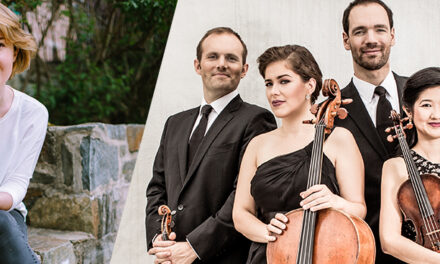Rodney Wynkoop and Vocal Arts Ensemble presented, as a gift to the community, a free concert at Duke Chapel. The music was of high quality, delivered with outstanding skill and winsome musicianship. If you have not read it yet, you are encouraged to read John Lambert’s review of Wynkoop’s years of association as Director of Chapel Music and performances of Handel’s Messiah. VAE, which dates from 1996 and presented its fifth Christmas concert tonight, is an extension of the excellence so eloquently described there.
The concert was titled O Holy Night, which happens to also be the title of VAE’s brand new, just released CD of 25 selections from past Christmas concerts. Several selections from the CD were included in this performance.
Opening the program was “Today the Virgin” by the English composer John Tavener (1944-2013). A setting of verses and refrain by Mother Thekla, the work conveyed the ethereal spirituality typical of this composer and filled Duke Chapel with glorious resonant harmony.
Frank Ferko’s “Adam lay ybounden” was a tightly woven piece with delicious dissonances resolved in unconventional ways. “Bogoróditse Dévo, ráduysia” by the Belarusian/American Sergey Khvoshchinsky was composed for The Rose Ensemble and very quickly became a favorite among choral groups world-wide as well as with audiences. In the style of a Russian Znamenny chant, it captures an ethereal quality with soprano duet counter melody and a spine chilling closing high B. The soprano soloists were Kristen Blackman and Karen Scherr.
Daniel Elder’s setting of “O magnum mysterium” emphasizes the mystery of the birth in a stable among the animals, by exploring the beauty of vocalized vowels and soft consonants, especially in the word “alleluia.”
Early German Baroque composer Samuel Scheidt wrote “A Child is born in Bethlehem,” a joyful celebration. The lively performance was graced by a lovely solo sung by Blackman.
“The Christ-child” is a setting of a poem by G. K. Chesterton in which the composer, Gabriel Jackson, employs impressive text-painting. The four verses describe the Christ-child’s hair as like a light, like a star, like a fire, like a crown. Each time this passage returns, the rich, rather dark harmony changes to a bright and open chord. The phrase “O weary, weary were the world” is underlined by repeated falling notes. Patty Philipps, who displayed a marvelous high tessitura, was the soloist.
The Swedish gem, “Strålande jul,” with text by Edvard Evers and music by Gustaf Nordqvist, simply overflows with Christmas images embellished with music of quiet warmth and beauty lovingly performed.
The first half of the concert ended gloriously with Francis Poulenc’s energetic setting of “Hodie Christus natus est.”
The second half of the concert featured more familiar Christmas carols, some in standard renditions and several in imaginative new arrangements. In the first half all works were sung a cappella. In the second half, five of nine were heard in choral/piano pairings with the skilled David Cole doing the piano honors. In the last piece, “Fum, fum, fum,” the scoring was for piano, four hands. David Stuntz provided the extra hands.
Of the accompanied pieces, the familiar 16th century English carol “What child is this?” was especially nice with arpeggios and obbligato accompaniment of the lilting melody. “Silent Night” (from Three Jazz Carols) was an exquisite arrangement by Will Todd. It began with the pianist playing a one-note reading of the familiar melody over soft humming harmony by the choir. It sounded like heavenly chimes. It was gorgeous all the way through.
Others with piano were the oh so lovely Austrian carol, “Still, still, still” and the always enchanting cradle song, “Away in a manger.”
Other unaccompanied choral selections were the traditional “The Holly and the Ivy,” “O Holy Night” in a dramatic and pleasing arrangement by Michael L Meyer, “En un burrito orejón” by Victor Schlichter, arr. Adrián A. Cuello Piraquibis and “We three kings,” arranged by Darmon Meader. For an encore, the choir sang “Sweeter Still” by Eric William Barnum. A lovely cradle song, it was a warmly gratifying way to wrap up the concert.
VAE is made up of some of the finest voices in the Triangle. Many are professional singers, choir directors, and highly trained musicians. They are chosen by Wynkoop based on ability, musicality, and the best possible blend of vocal qualities. Several selections on tonight’s program displayed that choral blend and balance. In addition, Wynkoop is the kind of choral conductor that singers are willing to travel considerable distances for the joy of singing and learning under his tutelage. His rehearsals are always focused and disciplined, a great pleasure, and often fun. They always accomplish something positive. I speak from experience.
Concerts of superior choral quality such as what was experienced in Duke Chapel this evening are the consequence of all of this. How fortunate we are.












